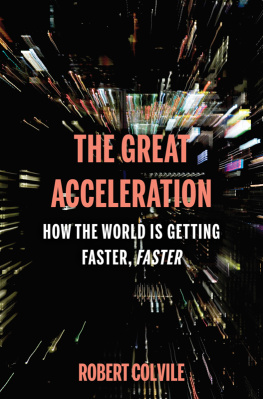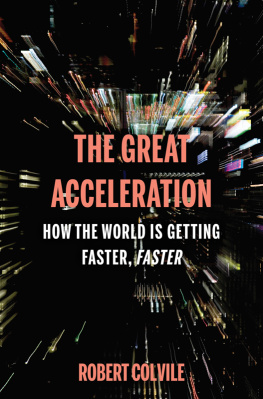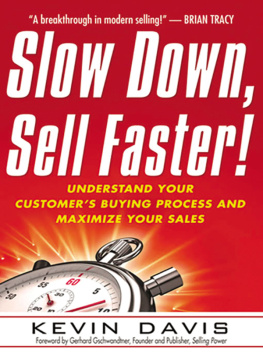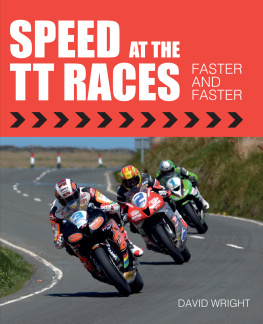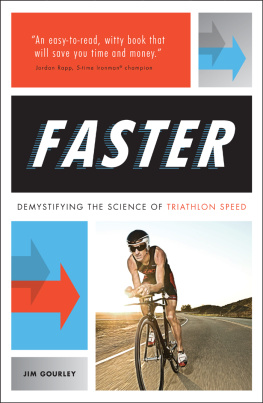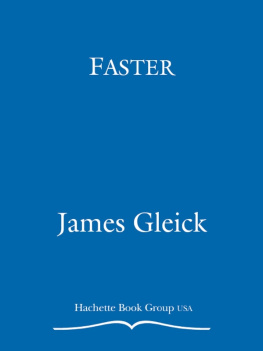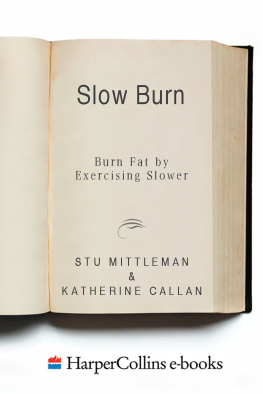THE GREAT ACCELERATION
How the World is Getting Faster, Faster
ROBERT COLVILE

To my father, who taught me how to take things slowly. And to Andrea, who makes my heart beat faster.
CONTENTS
All things move, all things run, all things are rapidly changing.
The Technical Manifesto of Futurist Painting
Next time you walk down the street, take a look at peoples feet. Pretty quickly you will notice that wherever you are, however large the crowd, they are marching in perfect lockstep. You can try to break the pattern to speed up or slow down but without a supreme effort, youll find that youve simply lengthened or shortened your stride: your feet are still marching to that same common beat.
This is, when you think about it, rather amazing. Our natural sense of rhythm is so strong, our inner beat so powerful, that it overrides our conscious thoughts. Even if youre listening to music, it doesnt matter: your iPhone may be pumping out Schubert while your neighbours plays Jay-Z, but your legs will remain in perfect synch.
The reason we fall into step is due to a phenomenon called entrainment, in which living creatures natural rhythms unconsciously adjust to each other. Its the same strange force that sees swallows wheel and dive in unison, or brings together the menstrual cycles of women who share the same house. And when it comes to walking, it would be natural to think that this collective pace is ruled by some primal biological rhythm, like the beat of our hearts. But in fact, it is set by our surroundings. In different places, people entrain in different ways: sometimes we are tortoises, sometimes hares.
This pace is determined, above all, by the nature of our environment. The larger the town or city, the faster people move: in the 19th century it was said that the average New Yorker always walks as if he has a good dinner before him and a bailiff behind him.
It is not just the size of communities that matters, however, but their culture. During a teaching sabbatical in Brazil, a Californian psychology professor called Robert Levine found his American obsession with punctuality utterly unsuited to the laid-back local norms. He decided to focus his research on why the pace of life varied around the world: so he and his students spent three years in the early 1990s visiting 31 different cities to measure the differences.
It turned out that the more advanced and industrialised the economy, and the more individualistic the culture, the faster the countrys speed. Western Europe and Japan hurried and scurried, while Africa and Latin America dawdled and lazed. Within America, the East Coast was the fastest, followed by the West, while the heartland ambled behind.
Yet cultures change over time and with them the speed of life. In 2006 a psychologist from the UK called Richard Wiseman enlisted the help of the British Council to carry out a rerun of Levines experiment. On a given day in August, its staff took to the streets of 32 cities around the world. Like Levines team a decade earlier, they staked out a 60-foot strip of unobstructed pavement in the heart of the city centre, grabbed a coffee, and started the stopwatches.
What did they find? That worldwide, people were covering the same stretch of ground in 10 per cent less time. In particular, the cities of Asia had caught the speed bug. Levine had been surprised that, despite their reputation for haste, the booming, bustling cities of the East were far less speedy than sclerotic old Europe (due, he theorised, to their warmer temperature). But during the years between the two experiments, Singapore and Guangzhou had come from nowhere to match the hastiest Western capitals just as the Asian economy had first borrowed the Wests hyperactive ethos, and then turbocharged it. In an act of wholesale cultural imperialism, America and Europe appeared to have impressed upon the developing world not only their individualistic, consumerist culture, but also a Western sense of haste.
THE GREAT ACCELERATION
What single quality best defines how our society is changing? Is it that life is becoming fairer, or more equal, or more prosperous? No: as the experiment above suggests, it is that life is getting faster. This is something many of us will have experienced for ourselves. This book, for example, was born out of the realisation that it was not just our electronic devices that were getting faster, nor the pace of our working lives. The media industry in which I worked, and the political system which I covered, were subject to sudden and convulsive change. New trends, ideas and crises appeared to be emerging in the blink of an eye. It felt like my friends and I had no time to relax, to unwind, to slow down.
The more I studied this phenomenon, the more I realised that it was all connected. In area after area, technology was making life quicker, more convenient, more friction-free not least as more and more of it moved online. The debates people were having about the internets effects on our brains, or our rapacious use of the planets resources, were all part of the same basic phenomenon: what I call the great acceleration.
In 1990, 49 per cent of Europeans felt their work schedule was too strenuous. By 2000, that had increased to 60 per cent and those who felt themselves to be rushed were almost twice as likely to complain of the classic stress disorders, such as back pain, or tight shoulders and necks.
The psychologist Stephanie Brown argues that Americas frenzied lifestyle has itself become an addiction. People are out of control in their push to do more, to always be on and available, and never to say no.
Yet at the same time, ours is a society in which speed is not just omnipresent, but venerated. Firms in Silicon Valley compete to be the quickest-moving, the most disruptive. A study of Christmas round-robin letters sent since the Sixties shows not only a remarkable rise in the use of words like hectic, whirlwind, consumed
As life speeds up, our patience thresholds dwindle. In 1999, websites would lose a third of their traffic if they took eight seconds to load. By 2006, that had shrunk to four.
It is not just our biology that is changing: our economy, too, is being altered in ways that many will not find comfortable. The process of disruption and automation the shift from manual labour to computer power is throwing industry after industry into turmoil, as first the working and now the middle classes discover that computers can do their jobs faster and cheaper than they can themselves. John Maynard Keynes called this technological unemployment and the faster technology moves, the less we are able to cope with the dislocation it causes.
Yet the central argument of this book is not only that acceleration is a good thing, but it is something that we have actively chosen. We are not mere passive victims of some vast, impersonal force: we have, collectively, chosen to bring the great acceleration on ourselves. We are, as humans, hard-wired to crave novelty, speed and convenience. Despite all the stress, people from faster places are far happier with their lives. As Levine found, faster overall tempos are highly related to a countrys economic well-being on every level: to the economic health of the country as a whole... to the economic well-being actually experienced by the average citizen... and to how well people are able to fulfil their minimum needs.cities are by and large doing so, as we shall see, with a spring in their step.
Set against a depressing picture of stress and uncertainty, indeed, is an equally powerful positive argument that in the words of Adrian Wooldridge, management columnist on
Next page
